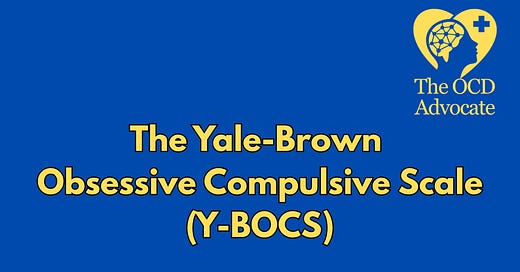The Yale-Brown Obsessive Compulsive Scale (Y-BOCS) is a tool for gauging the severity of OCD symptoms (e.g. intensity of obsessions, frequency of compulsions, and amount & types of obsessive themes).
The Y-BOCS is considered the gold-standard diagnostic tool for OCD used by clinicians [1], but it can also be a helpful tool that OCD sufferers can use to gauge their rate of progress during/after recovery programs (whether the programs are self-guided, therapist-guided, inpatient, or outpatient). There is also the DY-BOCS (“D” stands for “dimensional”), which is a more comprehensive version of the Y-BOCS [2]. There are also other variations on the Y-BOCS, such as the Y-BOCS II (updated version) and the CY-BOCS (a pediatric version). A qualified professional can give you guidance on which version is most relevant for you.
Y-BOCS as a tool for tracking progress over time
The Y-BOCS was used by my psychiatrist when I was formally diagnosed with OCD (over 20 years after I experienced the onset of the disorder), and since then I’ve used the assessment myself over different time periods to have a consistent measurement of how much OCD is impacting me at a given point in my life. When working toward any health goal, it’s valuable to have metrics to see if your efforts are working or not.
If your goal is weight loss, you’ll want to periodically measure your body weight, get a DEXA scan, or do body circumference measurements. If your goal is gaining strength, you’ll want to keep a training journal where you track reps, sets, and amounts of weights used for specific exercises over time. If your goal is to reduce OCD symptoms, you’ll want some kind of consistent measurement to track obsessiveness and compulsivity over time, and the Y-BOCS can be an effective tool in that regard.
If your Y-BOCS score is consistently going down (or maintaining at a low number) over long periods of time — excellent! Your OCD recovery efforts are working.
If your Y-BOCS score is going up (or maintaining at a high number) over long periods of time, you may need to re-assess your recovery strategies to see what requires adjustment so you can reduce OCD-related suffering.
Here’s a link to the Y-BOCS II if you want to take a look and use it for yourself: https://healccc.com/wp-content/uploads/2023/02/YBOCS-II-2020-fillable.pdf
IMPORTANT: The Y-BOCS should not be used to self-diagnose
I am absolutely not encouraging folks to self-diagnose using the Y-BOCS. Rather, I am saying the Y-BOCS can be used by the individual with OCD to track OCD symptoms after getting a diagnosis, being educated on what OCD is, and starting appropriate treatment. Diagnosis requires a thorough assessment from a qualified professional; it’s more than just filling out pages in a packet. Also, not everyone will be able to accurately understand the terminology and clinical verbiage in the Y-BOCS, which is another reason why individuals shouldn’t attempt to self-diagnose.
However, the Y-BOCS may provide helpful insights if you think you might have OCD but haven’t been diagnosed. For example, let’s say someone reads the Y-BOCS, goes through the entire assessment, and thinks, “Wow. Based on the information and my score, it really seems like I have OCD. This accurately explains my experiences so closely. I finally feel like I understand what’s going on with me.” That individual should then seek out a qualified psychiatrist/therapist to see if they truly have OCD. If they do, getting education and treatment guidance are the next steps.
My Y-BOCS scores throughout my life
The Y-BOCS has been helpful for me in tracking my OCD symptoms through my recovery process. At worst (a few years ago before I sincerely began recovery efforts), my Y-BOCS score was above 32 (extreme OCD symptoms) for about half a year. At best, my score was just under 15 (mild OCD). For the last year or so, I’ve been oscillating between the high end of mild OCD and the low end of moderate OCD.
References
Rapp, A. M., Bergman, R. L., Piacentini, J., & McGuire, J. F. (2016). Evidence-based assessment of obsessive–compulsive disorder. Journal of Central Nervous System Disease, 8, JCNSD-S38359.
Rosario-Campos, M. C., Miguel, E. C., Quatrano, S., Chacon, P., Ferrao, Y., Findley, D., ... & Leckman, J. F. (2006). The Dimensional Yale–Brown Obsessive–Compulsive Scale (DY-BOCS): an instrument for assessing obsessive–compulsive symptom dimensions. Molecular Psychiatry, 11(5), 495-504.





Thank you, as always, for such a helpful resource! 🩶 This is what my therapist is using to track my ERP treatment progress. 🌷